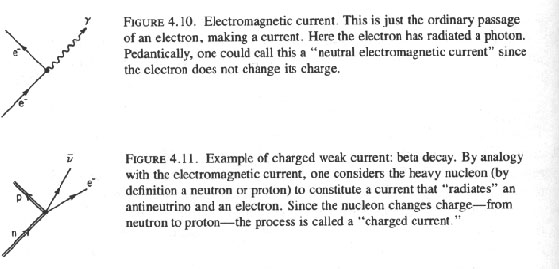![]()

Neutral Currents
Mayo was not kind enough to the readers. Her story about "neutral currents" begins without any explanation what "neutral currents" are. Maybe this does not affect the subsequent discussion, but it irritates most readers. Here are some passages and illustrations from Peter Galison, How Experiments End (1987):
In classical Lorentzian electrodynamics, an electrical current made up of particulate electrons is affected by continuous electromagnetic fields; quantum electrodunamics treats both electrons and the electrodynamic theory as having attributes of particles and fields. In particular, the fact that a current responds to an electromagnetic field is, in quantum electrodynamics, reflected in the statement that an electron can emit or absorb photons, the particle constituents of the electromagnetic field. Diagrammatically an electrodynamic current can therefore be represented by figure 4.10 with an electron absorbing or emitting a photon. By analogy, Fermi reasoned, beta decay could also be thought of in terms of a current. Instead of a (massive) electron emitting a (massless) photon, a (massive) neutron is considered to emit a (light relative to the neutron) electron and a (massless) neutrino (see figure 4.11). The salient difference between electrodynamic and weak currents was this: while an electron retained its charge during the emissive process, the neutron did not---it changed into a proton.
Subsequently, currents without a change of heavy-particle charge were dubbed neutral and those with such a change, charged. While we are discussing definitions, another piece of nomenclature will be useful: a lepton refers to all those particles that are not affected by the strong force such as electrons, neutrinos, and muons; a leptonic neutral current is a neutral current between leptons. A hadron is any strongly interacting particle; a hadronic neutral current is used somewhat freely to designate any neutral current that involves hadrons, though if both hadrons and leptons are involved, strictly speaking it should be called semileptonic. (152-153)
As you can see from figure 4.11, "beta decay" is a process in which the heavy nucleon (a neutron or proton), by a weak interaction, emits an electron and an antineutrino (or a positron and a neutrino), going into a more stable state. In contrast to this, a strong interaction occurs when elementary particles come within a very small distance; Yukawa's theory of meson was the first instance of the theory of this strong interaction.

In addition, Peter Galison also supplies the mathematical reasoning underlying the data (of HWPF experiment) Mayo quotes on page 96, namely:
- Visible muon eventsª@ª@56
- No visible muon eventsª@ª@54
- Calculated muonless eventsª@ª@24
- Excessª@ª@30
- Statistical significant deviationª@ª@5.1
What is crucial for Mayo's argument is the last number, for which, again, Mayo explains nothing ("standard deviation" and its explanation appear only in page 153). Let me quote Galison's explanation:
If the standard deviation of a sample of 24 and 56 events is approximated by their square roots, the ratio 24/56 has an error of (24ª}ª‹24) / (56 ª}ª‹56) , or 24/56 ª} (24/56)ª‹(1/24 + 1/56) = 24/56 ª} 0.105. Since the observed ratio (muonless events / visible muon events) minus the expected ratio is (54 -24)/56 = 0.536, the effect is 0.536/0.105 ªˆ5.1 standard deviations from the expected excess of zero, a powerful conclusion. (220-221)
Since Mayo suggests nothing of this sort (even informally), her description is unintelligible, to say the least. May I suggest that her materials in her book need rearrangement, if she wants her readers to understand what she is trying to get at?
INDEX- CV- PUBLS.- PICT.ESSAYS- ABSTRACTS- INDEXªELAPLACE- OL.ESSAYS-CRS.MATERIALS
November 30, 2000; last modified Jan. 26, 2003. (c) Soshichi Uchii